Efter en runda i byn var det dags för lite att äta.
Vi åt κεφαλοτυρί, μετιτσάνε σαλάτα και …νέφρι, dvs friterad ost, aubergine-sallad och en grillad köttbit.
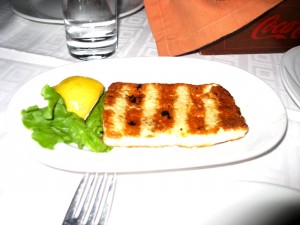
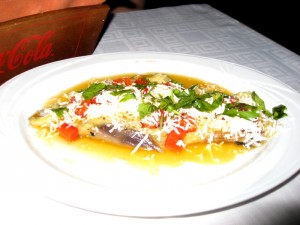
ENGLISH
After a stroll around the village we went to a very nice restaurant to have supper. We had κεφαλοτυρί, μετιτσάνε σαλάτα και …νέφρι, that is fried cheese, aubergine salad and grilled meat.
augusti 18th, 2008
Posted by
Eva |
Grekland, Resor |
no comments
På kyrkogården finns en präst begravd. Han önskan var att bli begravd stående, och det blev han också. Han finns i den höga graven med korset på. Hans ben har aldrig blivit uppgrävda. Till vänster om honom finns benen från Marias morföräldrar och en tant, alla samlade i samma grop och med delar från deras grav.

ENGLISH
On the cemetery a priest is buried. He wished to be buried standing up, and so he was. He stands inside the high monument with the cross on top. His bones have never been excavated. AT the left of his grave are the bones from Marias grandparents and an aunt. All together in the same hole and pieces of their grave stones on top.
augusti 18th, 2008
Posted by
Eva |
Grekland, Resor |
no comments
Eftersom det imorgon är Greklands största religiösa högtid skulle hon till sin pappas grav och tända ljus.
Jag har aldrig tidigare varit på en grekisk kyrkogård, bara sett på avstånd och då är de ju så bländande vita med all sin marmor. Jag blev därför väldigt förvånad över att se hur ful denna var när jag kom nära. Baksidan av gravarna var skräpiga, gångarna var av cement och skräpiga där var visset ogräs och trasiga gravstenar.
Så här funkar det i Grekland: efter tidigast 3 år, ofta 5 år, när mjukdelarna ruttnat, så grävs liket upp och benen tvättas. Därefter placeras benen i en låda. Denna låda kan placeras på en speciell förvaringsplats eller direkt på kyrkogården och då med delar av graven bredvid. En del gör en egen gravplats någon annanstans. Vid vissa högtider plockas benen fram och tvättas igen, de kysser dem och de läggs tillbaka i lådorna.
Inga kommentarer!
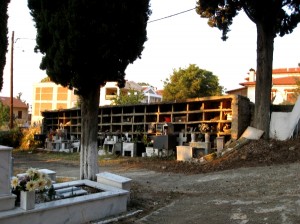
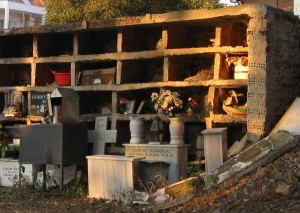
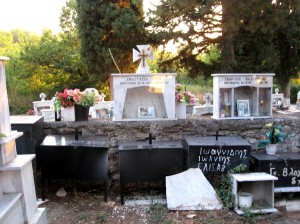
ENGLISH
Tomorrow its Greece’s biggest religious holiday and Maria wanted to light some candles on her fathers’ grave and other relatives.
I’ve never been to a Greek cemetery, only passed them on a distance and then they look very white and shiny with all the white marble. I was very surprised to discover that this one was very ugly. The back sides of the graves were very untidy and messy the paths were made of ugly concrete and there were dry weed and broken grave stones.
Here is how it works in Greece: 3 or 5 years after a person has been buried they excavate the body. The bones are washed and placed in a box. The box is put in a special place or just at the cemetery. And then they put parts of the gravestone beside it. Some fixes their own place. At certain religious events they bring out the bones and wash them, kiss them and put them back in the box.
augusti 18th, 2008
Posted by
Eva |
Grekland, Resor |
no comments
Följde med Maria till hennes by. Åkte 4 olika bussar på samma biljett, en vanlig stadsbiljett för 0,5 €. Byn ligger ca 2 mil från Thessaloniki.
Den var väldigt utsatt av nazisterna som hade tre ugnar här. Till minne av alla offer fanns en stor minnessten.
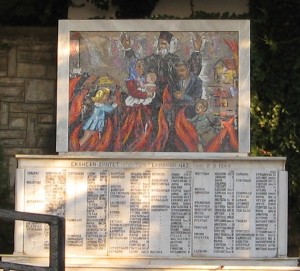
ENGLISH
Joined Maria to her village about 20 km from Thessaloniki, up on the mountain. Went with 4 different buses and on the same 0,5 € ticket.
The village suffered a lot during the war and the Nazis had 3 ovens here. In honour of the victims there is a memorial stone in the centre.
augusti 18th, 2008
Posted by
Eva |
Grekland, Resor |
no comments






